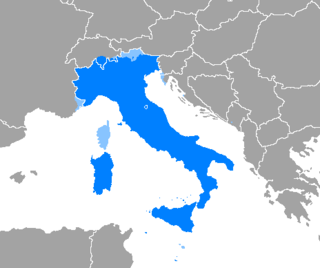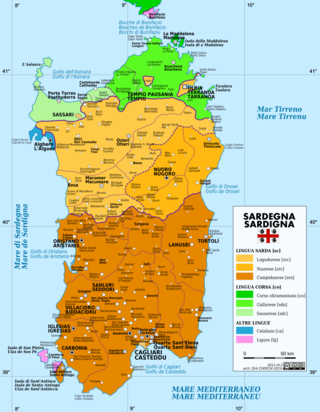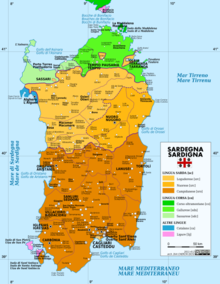
Italian is a Romance language of the Indo-European language family that evolved from the Vulgar Latin of the Roman Empire. Italian is the least divergent Romance language from Latin, together with Sardinian. Spoken by about 85 million people (2022), Italian is an official language in Italy, San Marino, and Switzerland, and is the primary language of Vatican City. It has official minority status in Croatia and in some areas of Slovenian Istria.

Latin phonology continually evolved over the centuries, making it difficult for speakers in one era to know how Latin was spoken before then. A given phoneme may be represented by different letters in different periods. This article deals primarily with modern scholarship's best reconstruction of Classical Latin's phonemes (phonology) and the pronunciation and spelling used by educated people in the late Roman Republic. This article then touches upon later changes and other variants. Knowledge of how Latin was pronounced comes from Roman grammar books, common misspellings by Romans, transcriptions into other ancient languages, and from how pronunciation has evolved in derived Romance languages.

The Romance languages, also known as the Latin or Neo-Latin languages, are the languages that are directly descended from Vulgar Latin. They are the only extant subgroup of the Italic branch of the Indo-European language family.

Logudorese Sardinian is one of the two written standards of the Sardinian language, which is often considered one of the most, if not the most conservative of all Romance languages. The orthography is based on the spoken dialects of central northern Sardinia, identified by certain attributes which are not found, or found to a lesser degree, among the Sardinian dialects centered on the other written form, Campidanese. Its ISO 639-3 code is src.

Campidanese Sardinian is one of the two written standards of the Sardinian language, which is often considered one of the most, if not the most conservative of all the Romance languages. The orthography is based on the spoken dialects of central southern Sardinia, identified by certain attributes which are not found, or found to a lesser degree, among the Sardinian dialects centered on the other written form, Logudorese. Its ISO 639-3 code is sro.
In linguistics, lenition is a sound change that alters consonants, making them more sonorous. The word lenition itself means "softening" or "weakening". Lenition can happen both synchronically and diachronically. Lenition can involve such changes as voicing a voiceless consonant, causing a consonant to relax occlusion, to lose its place of articulation, or even causing a consonant to disappear entirely.
Italian orthography uses 21 letters of the 26-letter Latin alphabet to write the Italian language. This article focuses on the writing of Standard Italian, based historically on the Florentine dialect, and not the other Italian dialects.
The phonology of Catalan, a Romance language, has a certain degree of dialectal variation. Although there are two standard varieties, one based on Central Eastern dialect and another one based on South-Western or Valencian dialect, this article deals with features of all or most dialects, as well as regional pronunciation differences.
Regional Italian is any regional variety of the Italian language.
The phonology of Italian describes the sound system—the phonology and phonetics—of Standard Italian and its geographical variants.

Central Italian refers to the dialects of Italo-Romance spoken in the so-called Area Mediana, which covers a swathe of the central Italian peninsula. Area Mediana is also used in a narrower sense to describe the southern part, in which case the northern one may be referred to as the Area Perimediana, a distinction that will be made throughout this article. The two areas are split along a line running approximately from Rome in the southwest to Ancona in the northeast.

Murcian is a variant of Peninsular Spanish, spoken mainly in the autonomous community of Murcia and the adjacent comarcas of Vega Baja del Segura and Alto Vinalopó in the province of Alicante (Valencia), the corridor of Almansa in Albacete. In a greater extent, it may also include some areas that were part of the former Kingdom of Murcia, such as southeastern Albacete and parts of Jaén and Almería.
Tamil phonology is characterised by the presence of "true-subapical" retroflex consonants and multiple rhotic consonants. Its script does not distinguish between voiced and unvoiced consonants; phonetically, voice is assigned depending on a consonant's position in a word, voiced intervocalically and after nasals except when geminated. Tamil phonology permits few consonant clusters, which can never be word initial.
In phonology, voicing is a sound change where a voiceless consonant becomes voiced due to the influence of its phonological environment; shift in the opposite direction is referred to as devoicing or desonorization. Most commonly, the change is a result of sound assimilation with an adjacent sound of opposite voicing, but it can also occur word-finally or in contact with a specific vowel.
As a member of the dialect continuum of Romance languages, Catalan displays linguistic features similar to those of its closest neighbors. The following features represent in some cases unique changes in the evolution of Catalan from Vulgar Latin; other features are common in other Romance-speaking areas.
In the Romance languages, metaphony was an early vowel mutation process that operated in all Romance languages to varying degrees, raising certain stressed vowels in words with a final or or a directly following. This is conceptually similar to the umlaut process characteristic of the Germanic languages. Metaphony is most extensive in the Italo-Romance languages, and applies to nearly all languages of Italy. However, it is absent from Tuscan, and hence from Standard Italian.

Ingrian is a nearly extinct Finnic language of Russia. The spoken language remains unstandardised, and as such statements below are about the four known dialects of Ingrian and in particular the two extant dialects.
The conjugation of Sardinian verbs are mainly divided according to infinitives into -are, -ere, and -ire verbs in north-central dialects for regular verbs, similar to the tripartite systems of Portuguese, Spanish, and Italian. In southern dialects, these infinitives above change to -ai, -i, and -iri, respectively. Irregular verbs also exist as well. Many Sardinian conjugated forms were similar and conservative phonologically to Classical Latin, although the number of tenses were greatly reduced and the remaining tenses rely on periphrasis.
Palatalization in the Romance languages encompasses a variety of sound changes in Late Latin and in the languages descended from it that caused consonants to gain a palatal or palatalized pronunciation, generally through the influence of an adjacent consonant or vowel. This eventually resulted in the development of a series of palatal or postalveolar consonants in most Romance languages, e.g. Italian.








